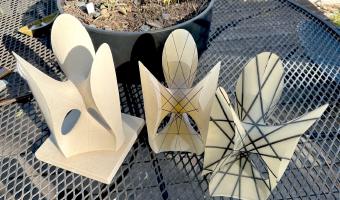
Since 1999, independent researcher and architect Jonathan Chertok has been digitally reconstructing and 3D-printing historical plaster models from 19th-century mathematical model collections, originally hand-crafted in the 1860s and cataloged in early 20th-century German sources. His work focuses in particular on the Klein-Schilling collection, many of whose originals are housed in European institutions such as the University of Göttingen and the Institut Henri Poincaré in Paris.
Chertok’s “1.0 […]
Since 1999, independent researcher and architect Jonathan Chertok has been digitally reconstructing and 3D-printing historical plaster models from 19th-century mathematical model collections, originally hand-crafted in the 1860s and cataloged in early 20th-century German sources. His work focuses in particular on the Klein-Schilling collection, many of whose originals are housed in European institutions such as the University of Göttingen and the Institut Henri Poincaré in Paris.
Chertok’s “1.0 phase” involved a series of digitally modeled and 3D-printed reproductions presented at ACM SIGGRAPH 2008, including classic surfaces such as the Clebsch diagonal cubic, recreated using a combination of mesh-based mathematical modeling and NURBS-based CAD design. The left photo shows 3D-printouts of the Clebsch surface he made in 2004–2005. Chertok’s current “2.0 phase” aims to document and produce over 100 additional models, including forms only fully formulated in the late 20th century. This work is informed by archival research, field visits, historical photography, and computational scripting. The right photo shows some of the models he printed so far.
This long-term effort is both a digital preservation project and a contemporary reinterpretation of early mathematical visualization. Chertok’s aim is to revive these artifacts as part of a global cultural patrimony, while exploring their potential use in STEM education, exhibition design, and interactive learning tools. He is currently seeking collaborators—particularly from academic or curatorial backgrounds—to help him organize, document, and publicize the project as he prepares for a second exhibition phase and possible online release.
Related: Also see our entry 1880 – Klein’s Mathematical Plaster Models
Sources:
Most of the information and the two photos come from a personal correspondence with Jonathan Chertok. Jonathan D. Chertok (2008) Artifacts of research: on singularities. ACM SIGGRAPH 2008 new tech demos. Joshua Bateson (2014) This Is What Math Equations Look Like in 3-D. Wired Article for which Jonathan Chertok provided photos. The Phillips Collection (2015) Man Ray–Human Equations. Exhibition about Man Ray featuring some of Chertok’s physical models. Elkadi, Mourrain, and Piene (2006). Algebraic Geometry and Geometric Modeling. Book that mentions Chertok’s work on p.120. Tobies and Pakis. Felix Klein: Visions for mathematics, applications, and education. Briefly mentions Chertok’s work on p.175.



